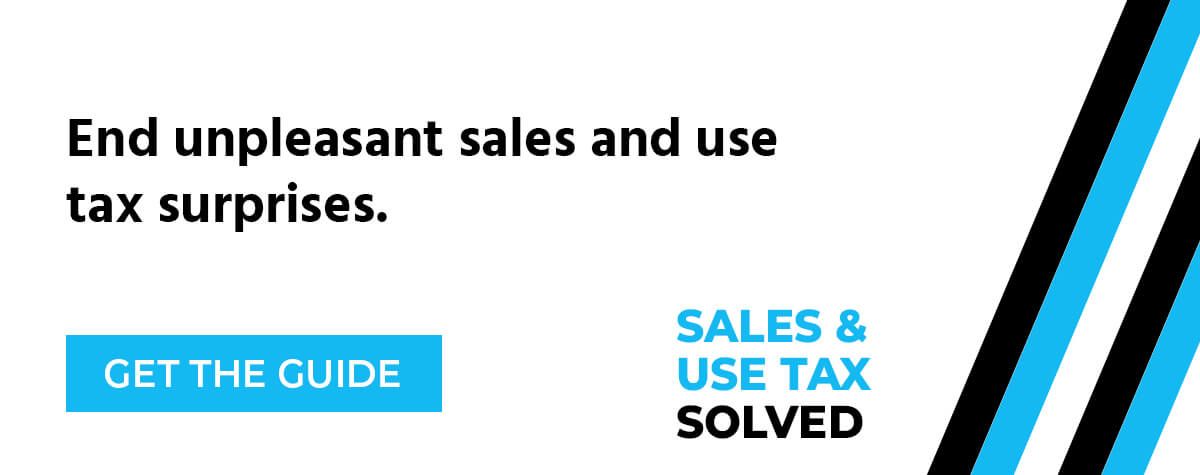This blog was last updated on September 2, 2021
@media (min-width: 1060px) { .div-ad { width: 60%; float: right; padding: 25px; margin-bottom: 25px; margin-left: 25px; margin-right: -100px; box-shadow: 3px 3px 3px #ebedef; } } .div-ad-link { color: #015FFF; text-decoration: underline !important; } @media (min-width: 1060px) { .pja-image { width: 60%; float: left; padding-left: 15px; margin-right: 25px; margin-left: -100px; } } @media (max-width: 1060px) { .pja-image { display: block; margin-left: auto; margin-right: auto; } }
When business is booming, the last thing you want to do is focus on tax liability.
But as you expand, so does complexity. Moving into new geographic areas or creating new products and services will likely affect your business’ sales tax obligations, so it’s vital to keep up with new requirements as you grow.
After all, tax authorities will be watching. Many are implementing new tax regulations and examining compliance under a microscope. Make sure these regulators don’t find anything amiss with your sales and use tax filings as you manage the mounting complexity of adhering to thousands of ever-changing regulations.
Changes to your business mean changes to your taxes
Keeping up with changes in sales and use tax obligations due to business expansion complicates the already-difficult job of making sure your tax remittances comply with the moving target of state nexus laws.
As you may know all too well, the U.S. has more than 12,000 tax jurisdictions, each with its own sales and use tax rules and rates. The types of activities that can trigger nexus expanded in 2018 with the South Dakota v. Wayfair decision, opening the door to economic nexus. The number of states with economic nexus rules on the books has ballooned since then, with the threshold varying among states.
As you expand, you’ll be responsible for sales tax in new places and will have to track the tax laws for any new products you introduce. If you’re selling to other businesses, you’ll need to track which are exempt from paying sales tax and maintain documentation to prove it, a task that becomes more complicated as you do more business in more places.
This is next-to-impossible to keep on top of on your own, and many digital tools have proven that they aren’t up to the task either. Your inefficient or unreliable system for handling sales and use tax will eventually reach a tipping point where managing it is more trouble than it’s worth.
Instead, you need an efficient, reliable, always-up-to-date solution to ensure you can keep up with the wild world of U.S. sales and use tax laws as your business evolves.
More in the “Sales and Use Tax Solved” series:
ARTICLE: If cars can drive themselves, should filing sales and use tax be so hard?
ARTICLE: It’s 2021. No more unpleasant sales and use tax surprises
Growing? More states have their eyes on you
Sales taxes are the second-largest source of revenue in most states after property taxes. Since South Dakota v. Wayfair enabled states to collect more sales and use tax, they’re subjecting sales tax collections to ever-greater levels of scrutiny.
As you grow and expand into new territories, that scrutiny will be even more intense from states you haven’t worked in before.
In the days before nexus laws were expanded, larger enterprise businesses predicted an audit in each jurisdiction every three years. Now, small and medium businesses should expect to be audited, too, especially as new taxpayers in jurisdictions you haven’t paid taxes in before.
For tax, growth and automation go hand-in-hand
With your tax obligations multiplying as your company expands, you’re likely to find it difficult — if not impossible — to prepare error-free sales and use tax tax filings without an automated solution that can keep up with the complex, constantly changing tax landscape.
Compliance problems are almost inevitable during periods of high business growth. If you can somehow manage to reconcile your sales and use tax by hand, you’re likely to discover that errors are creeping in (and also feel the strong urge to take a vacation by the end of the process).
When these problems start cropping up, automating your sales and use tax functions starts making a lot of sense. But it’s important to ensure the automation tool you choose is up to the task.
You’ll want to avoid headaches like random glitches, out-of-date forms, last-minute approvals without the backup to know they’re correct, lagging customer service, and inexplicable billing changes.
Using Sovos allows you to handle taxes without worrying about time-crunches, compliance problems, or aggravation. Download our guide to learn more about how we’ve simplified the surprises right out of sales and use tax.
